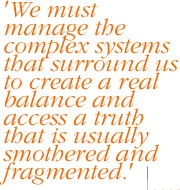

 |
 |
Chapter summary
What's brand got to do with it?
There is a very real sense of cynicism, frustration, disappointment and fear at large in the business world today.
I see many sceptical clients searching for a better way. The business background to which I refer is often one of a fragmented, constrained, defined, silo-ed, splintered and segmented enterprise. Today's organizations (and the employees and customers which rely upon them) seem ever more dysfunctional and disconnected from one another, divided by rather than encouraged by systems, processes and management legacies. I'm not alone in feeling like this I know, but that doesn't make me any happier about what's going on in the name of business, or even worse what is perpetrated in the name of branding.
I'm not at all a fan of the consultancies and agencies who drone on about this method or that tool or that doctrine related to the god of Branding, they seem far too self-serving and when I was a client they certainly didn't impress me. I hadn't a clue what many of them were talking about.
Is it the business of branding or the branding of business that is at fault? Or neither? Of course the answer is both. And this chapter hopefully sets out to make some sense of it.
I believe it is wholly un-constructive and very dangerous to deal with the effects of these disconnections in isolation from their causes, and in isolation from one another. Relentless innovation and organizational re-engineering is all very well, and crucial to human progress. But what is required - simultaneously - is a little renovation, ingenuity, creativity and some constructive support, a framework understood as much by the client as those aiming to help.
I describe the totality of what an integrated business actually looks like, a brand equation and brand framework which is co-created together with the interested parties, our clients. A new mould perhaps, a different approach certainly.
For almost twenty years I have been dealing with the effects and the fall out from the toxic waste of failing to address the issues of deliberate disconnectedness and shared misunderstanding. I've learned this lesson through bitter first hand and often costly experience and then developed and applied the solutions I describe in the chapter in response to it.
I believe we need a fundamental shift from just the creation of content - to a vital and living liberation of context.
In describing the complete context the aim is to assist leaders of business to catch a glimpse of a very real and achievable world in which branding can reconnect to a serious business agenda, and in which businesses can successfully exploit the strengths and relationship opportunities that brands when working well can create. Actually it's all about managing the complex and complete systems that surround us to create a real balance and harmony and access a truth that is sadly usually smothered and fragmented.
My approach is that without interrupting the existing entrenched processes and adopting fresh 'multi-sensual' frameworks to dramatically accelerate understanding of the connected enterprise we will fail to build humanly sustainable businesses optimised to win in the future.
The world of 'beyond branding' is a world where context matters as much, if not more than content.
This is about liberating value.
Read more in the full book
Next chapter:
Brand Sustainability: What is to be done?
